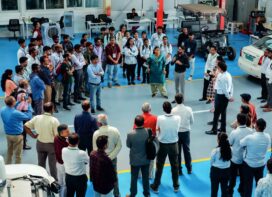Approximately 70% of the applications available on the ITMS platform have been implemented in the Greater Hyderabad area of Telangana State comprising three Commissionerates, Hyderabad City, Cyberabad and Rachakonda. Key goals in the first phase including increase in average traffic speed, improving road safety, reducing pollution and improving AQI have been met to a degree. Consistency has been key to improved performance even with 86 lakh vehicles on the road and more added every day. Narsing Rao Motta, DSP, Telangana State ICCC (Integrated Command and Control Centre), spoke to Trafficinfratech on his experience in implementing Intelligent Transport Management Systems in Hyderabad City and future goals including cop-less junctions.
One of the major goals for implementing ITMS was to increase the average speed of commute in the city. The tool captured the origin and destination of each vehicle with date, time and distance travelled. Multiple patterns were established for different time-slots and locations for the 6 lakh vehicles on the road every day. Field officers took decisions on clearing traffic and road diversions especially during peak hours between 9am and 11am. The analysis on volume data and quick action on the ground ensured consistency in the travel time of commuters and an increase in average speed by 32%. Prior ITMS implementation, the average speed in Hyderabad City was 19 kms/hr. Over the course of four years, the average speed has increased to 25 kms/hr.
Signal systems for improved road safety
Adaptive Traffic Signal Control (ATSC) systems, including Vehicle Actuated Control and Pelican Signals have been rolled out for better traffic and pedestrian management at junctions in the state capital. ATSC systems adjust when green lights start and end to accommodate current traffic patterns thus promoting smooth flow of traffic and easing congestion. Unlike regular traffic signals, the ATSC systems will automatically and continuously adjust the green times based on changing arrival patterns of vehicles at an intersection, with the objective of optimising a combination of delay and number of stops.
The key features of the implementation include central control of corridor traffic signals, signal timings based on changing traffic patterns, camera-based traffic sensors and power backup through both solar and batteries. Project benefits include enhanced travel time reliability, less waiting times at junctions, reduction in city-wide congestion, fewer stops, fewer emissions and improved road safety.
Despite addition in the daily number of vehicles, congestion has been either consistent or reduced on key corridors with increase in travel speed. Data shows reliable travel experience, reduced vehicular pollution, reduced signal timing, congestion and improved traffic situation. There has been approximately 3.6 mn. road user hour savings per month and 2600 tons of emission savings per month, according to an analysis done post implementation. The difference in the figures of road fatalities in 2016 and post implementation in 2023 show a drastic reduction in the city. Traffic signal systems are run 24×7, another reason for reduced fatalities. Hyderabad has consistently shown good air quality with an AQI less than 100.
The Pelican signal system is a type of pedestrian crossing system that helps people cross roads safely. The 45 signals in various locations in the city are operated by trained traffic volunteers as citizens are still not accustomed to using these services. The system is designed to ensure that pedestrians have enough time to cross the road before the traffic signal turns green for vehicles.
Incident Management
Use of the ITMS platform has helped in planned and unplanned incident management. Programs fixed in advance like government and religious functions, celebrations and the biggest of all, the immersion of Ganesh idols which take place over two days with lakhs of devotees in attendance, are all managed with the help of ITMS simulations. Notifications and alerts on traffic restrictions, congestions and diversions are shared with the public via Variable Message Sign (VMS) boards, traffic police social media handles like Facebook and Twitter, FM radio channels and field officers.
Implementation Partners
The major vendors in the Greater Hyderabad ITMS implementation are system integrators IBI, infrastructure implementors L&T and their partner for ANPR cameras Vehant Technologies, with the support of Osmania University in monitoring the entire ITMS project.
Compliance on violations
People behaviour on roads remains the same. When abroad they will follow all traffic rules but not so in their home country. However, automated enforcement through the ITMS online challan system has made vehicle owners wary of no-compliance. An SMS alert with the link is sent to the violator. On clicking the link, the vehicle owner can see the image of the violation including jumping signals, wrong-side driving, non-helmet wearing. Traffic police have ensured more than 60% compliance by way of fine collection.
Looking ahead
More than 30% features of the ITMS platform are yet to be used. The next phase will be to implement cop-less junctions across the city. Presently, there are cops at every signal to ensure commuters follow traffic rules as the physical presence of a policeman is still required to ensure discipline. The cop-less feature has been experimented within certain places and the initial response has been favourable. Road infrastructure including road furniture and signages have to be improved. Implementing the Free-left Obstruction feature is another milestone to be achieved in the next phase.
 TrafficInfraTech Magazine Linking People Places & Progress
TrafficInfraTech Magazine Linking People Places & Progress


